UNIT 9 HUMAN BIOLOGY LESSON 3课件(共36张,内嵌视频)--高中英语北师大版(2019)选择性必修第三册
文档属性
| 名称 | UNIT 9 HUMAN BIOLOGY LESSON 3课件(共36张,内嵌视频)--高中英语北师大版(2019)选择性必修第三册 | 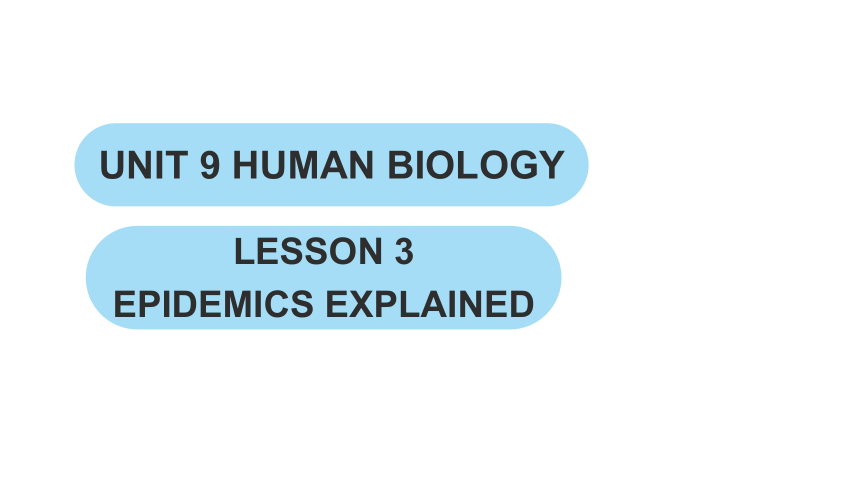 | |
| 格式 | pptx | ||
| 文件大小 | 9.9MB | ||
| 资源类型 | 教案 | ||
| 版本资源 | 北师大版(2019) | ||
| 科目 | 英语 | ||
| 更新时间 | 2025-04-03 22:13:32 | ||
图片预览

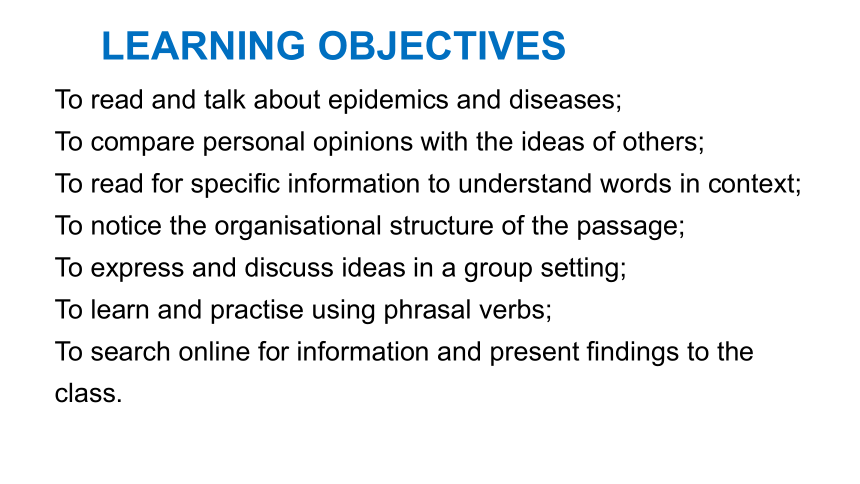



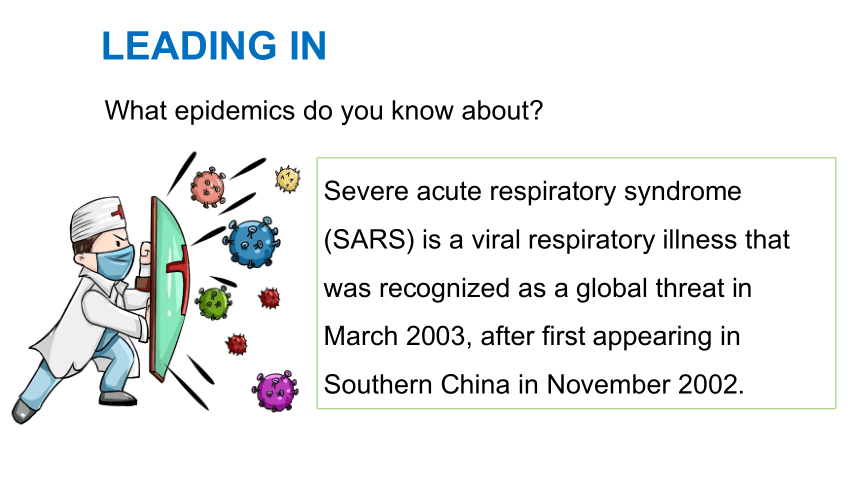
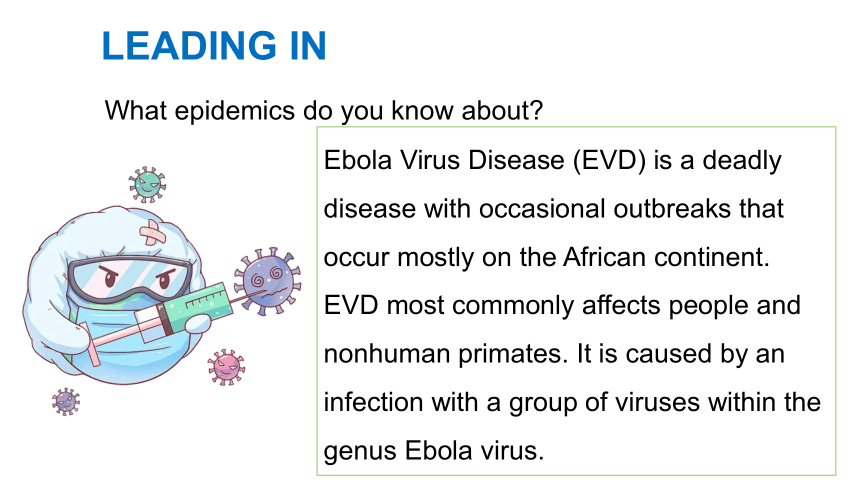
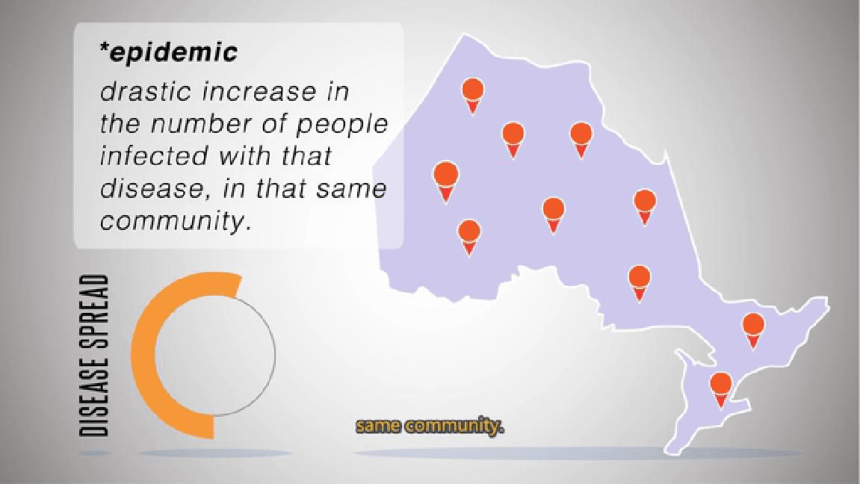

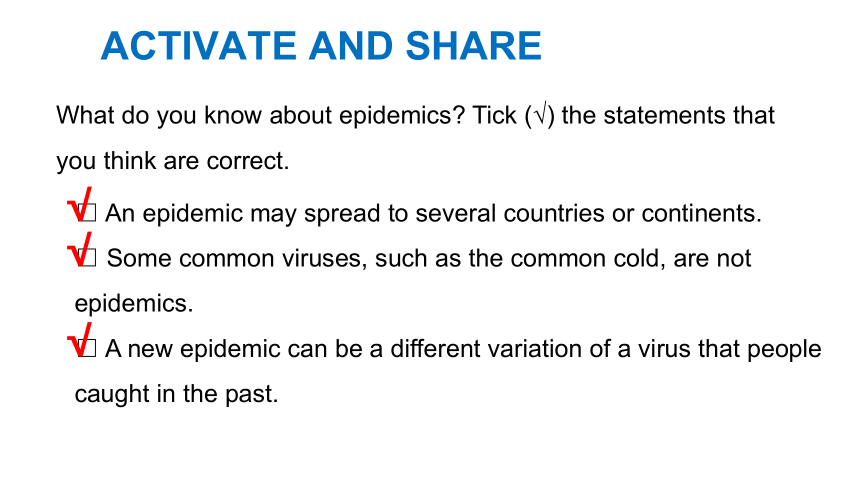
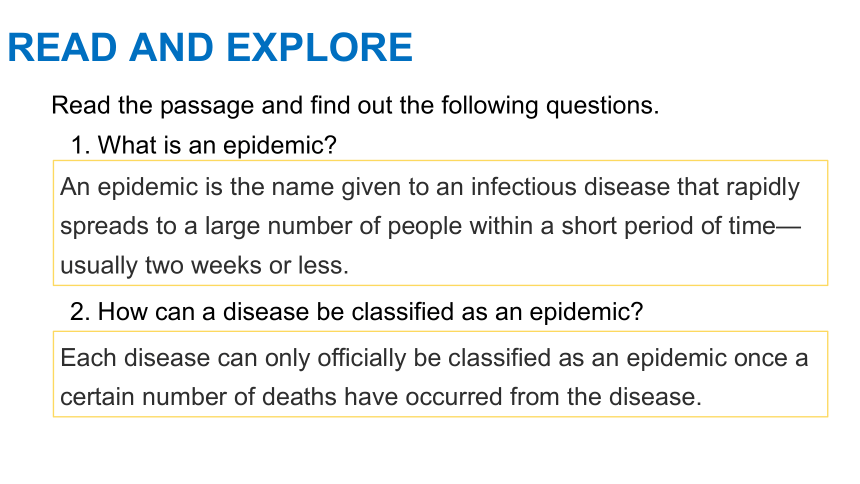

文档简介
(共36张PPT)
LESSON 3
EPIDEMICS EXPLAINED
UNIT 9 HUMAN BIOLOGY
LEARNING OBJECTIVES
To read and talk about epidemics and diseases;
To compare personal opinions with the ideas of others;
To read for specific information to understand words in context;
To notice the organisational structure of the passage;
To express and discuss ideas in a group setting;
To learn and practise using phrasal verbs;
To search online for information and present findings to the class.
KEY POINTS AND DIFFICULT POINTS
To answer the comprehension questions;
To get key information in the text;
To get the organisational structure of a passage;
To learn words and expressions in context;
To struggle with complicated sentence structures;
To think critically and express opinions freely.
LEADING IN
What epidemics do you know about
LEADING IN
What epidemics do you know about
COVID-19 is a new strain of coronavirus that has not been previously identified in humans. The COVID-19 is the cause of an outbreak of respiratory illness first detected in Wuhan, Hubei province, China.
LEADING IN
What epidemics do you know about
Severe acute respiratory syndrome (SARS) is a viral respiratory illness that was recognized as a global threat in March 2003, after first appearing in Southern China in November 2002.
LEADING IN
What epidemics do you know about
Ebola Virus Disease (EVD) is a deadly disease with occasional outbreaks that occur mostly on the African continent. EVD most commonly affects people and nonhuman primates. It is caused by an infection with a group of viruses within the genus Ebola virus.
LEADING IN
Epidemics VS Pandemics
What do you know about epidemics Tick ( ) the statements that you think are correct.
□ An epidemic is the rapid spread of an infectious disease.
□ An epidemic can affect a large number of people in a given population.
□ An epidemic can occur within a short period of time, usually two weeks or less.
√
√
ACTIVATE AND SHARE
√
What do you know about epidemics Tick (√) the statements that you think are correct.
□ An epidemic may spread to several countries or continents.
□ Some common viruses, such as the common cold, are not epidemics.
□ A new epidemic can be a different variation of a virus that people caught in the past.
√
√
ACTIVATE AND SHARE
√
Read the passage and find out the following questions.
READ AND EXPLORE
1. What is an epidemic
An epidemic is the name given to an infectious disease that rapidly spreads to a large number of people within a short period of time—usually two weeks or less.
2. How can a disease be classified as an epidemic
Each disease can only officially be classified as an epidemic once a certain number of deaths have occurred from the disease.
Read the passage. Find out what an epidemic is and how a disease can be classified as an epidemic, Then circle all the epidemics mentioned in the passage.
READ AND EXPLORE
bird flu,
the 1918 Spanish Flu,
the Black Death,
SARS,
the Ebola Virus Disease (EVD)
How does the passage develop
A. In order of time
B. In order of space
C. In order of logic
D. In order of place
√
Read the passage and answer the following questions.
READ AND EXPLORE
1. What is an epidemic
A. It is an infectious disease.
B. It is a disease that spreads rapidly.
C. It is a disease that kills a great number of people.
D. It is an infectious disease that spreads rapidly.
√
Read the passage and answer the following questions.
READ AND EXPLORE
2. Which of the following statements is right about an epidemic
A. A disease which causes deaths can be classified as an epidemic.
B. A disease which spreads rapidly can be classified as an epidemic.
C. Epidemics have been happening for as long as there have been people living on Earth.
D. Epidemics can only be caused by a virus or bacteria.
√
Read the passage and answer the following questions.
READ AND EXPLORE
3. Which of the following can cause epidemics according to the passage
A. A virus carried into an area.
B. Fewer people living in an area.
C. People catching a common cold.
D. A woman having a high fever.
√
Read the passage and answer the following questions.
READ AND EXPLORE
4. What can we know about bird flu according to Paragraph 4
A. It first appeared in 1987.
B. It has taken over one thousand lives.
C. It is a modern adaptation of the 1918 Spanish Flu.
D. People don’t worry that it could be the next global epidemic.
√
Read the passage and answer the following questions.
READ AND EXPLORE
5. What is the visible symptom of The Black Death
A. The eyes become terribly red.
B. The body has black spots.
C. People have a high fever.
D. People cough a lot.
√
Read the passage and answer the following questions.
READ AND EXPLORE
6. Which of the following epidemics is believed to have been the most severe in history
A. The SARS.
B. The Ebola Virus Disease.
C. The bird flu.
D. The Spanish Flu.
√
Read the passage and answer the following questions.
READ AND EXPLORE
7. What does the writer want to convey in the passage
A. He wants to tell us the history of epidemics.
B. He wants to call on the countries worldwide to unite to conduct thorough and systematic medical research on epidemics.
C. He wants to warn us of the danger of epidemics.
D. He wants to give the definition of an epidemic.
√
Read the passage and figure out the structure.
READ AND EXPLORE
Epidemics explained
Part 1 (Para.1-2)
Basic information about epidemics: definition, cause, difference
Part 2 (Paras.3-8)
Epidemics in history (Examples)
Part 3 (Para.9)
Measures to fight against epidemics
READ AND EXPLORE
Pair Work Read the passage again. Complete the table about the epidemics mentioned. Then choose one disease to talk about with a partner.
Name Period Places Death toll
Bird Flu ×
Epidemics in the Roman Empire
The Black Death ×
since 1997
more than a hundred lives
500—550 CE
Rome
half the population
1330s
Asia and Europe
READ AND EXPLORE
Pair Work Read the passage again. Complete the table about the epidemics mentioned. Then choose one disease to talk about with a partner.
Name Period Places Death toll
The Spanish Flu ×
SARS ×
EVD
1918—the end of World War I
50 million people
2002—2003
China, Canada, Vietnam and Singapore
2013—2016
West Africa
more than 11310 death
Tick (√) the aspects of information that are mentioned in the passage.
□ when epidemics started
□ examples of epidemics
□ treatments
□ baseline number of deaths of epidemics
√
READ AND EXPLORE
□ definition
□ when it ended
□ possible causes of epidemics
□ possible solutions
√
√
√
√
√
READ AND EXPLORE
Skill Builder
Developing Concepts Based on the Text
Concepts are not always clearly defined in a text. You need to read and develop your understanding.
Read the text to get the general idea.
Identify all the information related to the concept, e.g. examples, developments, effects, etc.
Organise the information and explain the concept from different angles.
READ AND EXPLORE
Use a diagram to demonstrate in a logical way how the aspects of information are organised.
Epidemics
definition of epidemics
examples of epidemics
baseline number of deaths of epidemics
when epidemics started
when it ended
READ AND EXPLORE
1. What are the main features of an epidemic Give at least two examples to illustrate your points.
Group Work Discuss the questions.
The main features of an epidemic: (1) it is an infectious disease (2) it spreads rapidly to a large number of people within a short period of time (3) a certain number of deaths have occurred from the disease. The common cold is not an epidemic because while it affects many people, it does not cause deaths. SARS affected many people and caused many deaths, so it is considered an epidemic.
READ AND EXPLORE
2. What should different countries do to prevent outbreaks of epidemics in the future Why
Group Work Discuss the questions.
Countries will need to work together to do this because teamwork among nations across the globe can save lives. This is a good example of building a community with shared future for mankind.
READ AND EXPLORE
3. What does the title mean to you What does the writer want to convey in the passage
Group Work Discuss the questions.
The title means that the passage will explain questions about epidemics. The author wants to convey the information that we are always on our way to find an explanation to epidemics so as to find cure. It also implies that epidemics occurred naturally and inevitably. We can only explain it, and cannot prevent it or stop it completely now.
READ AND EXPLORE
4. What do you think the passage is written for
Group Work Discuss the questions.
This is a popular science article. It is more likely to be written for people who are interested in this topic or who have a lot of questions or misunderstanding of epidemics.
READ AND EXPLORE
Complete these sentences in your own words.
1. Epidemics can be caused by …
2. Diseases can only be officially classified as epidemics when …
3. The Spanish Flu spread worldwide because …
4. Since the end of the SARS epidemic, scientists …
5. Countries need to work together to conduct thorough and systematic research because …
READ AND EXPLORE
Complete these sentences in your own words.
1. Epidemics can be caused by a virus being carried into an area, or changes in the way people live.
2. Diseases can only be officially classified as epidemics when a baseline number of people have died from the disease.
3. The Spanish Flu spread worldwide because soldiers and other people were moving and travelling around the world after World War I.
READ AND EXPLORE
Complete these sentences in your own words.
4. Since the end of the SARS epidemic, scientists have been doing experiments on treatments to prevent further outbreaks.
5. Countries need to work together to conduct thorough and systematic research because teamwork among nations across the globe can save lives.
EXPRESS YOURSELF
Search online and find some information about epidemics in China or Asia. Report your information to the class.
PRACTICE
1. Vaccine supplies started to run dry as the flu outbreak reached ____________ (epidemic) proportions.
2. The risk of ____________ (infect) is appreciably higher among children.
3. The strain in a long term of years has told ____________ (severe) on his health.
4. That's how ____________ (concept) like general welfare start to sound quaint in this age.
epidemic
infection
severely
concepts
SUMMARY
Read and talk about epidemics and diseases;
Analyze the organisational structure of the passage;
Express and discuss ideas in a group setting;
Compare personal opinions with the ideas of others;
Read for general understanding and specific information;
Understand and learn words and expressions in context;
Learn and practise using phrasal verbs.
Thank you
LESSON 3
EPIDEMICS EXPLAINED
UNIT 9 HUMAN BIOLOGY
LEARNING OBJECTIVES
To read and talk about epidemics and diseases;
To compare personal opinions with the ideas of others;
To read for specific information to understand words in context;
To notice the organisational structure of the passage;
To express and discuss ideas in a group setting;
To learn and practise using phrasal verbs;
To search online for information and present findings to the class.
KEY POINTS AND DIFFICULT POINTS
To answer the comprehension questions;
To get key information in the text;
To get the organisational structure of a passage;
To learn words and expressions in context;
To struggle with complicated sentence structures;
To think critically and express opinions freely.
LEADING IN
What epidemics do you know about
LEADING IN
What epidemics do you know about
COVID-19 is a new strain of coronavirus that has not been previously identified in humans. The COVID-19 is the cause of an outbreak of respiratory illness first detected in Wuhan, Hubei province, China.
LEADING IN
What epidemics do you know about
Severe acute respiratory syndrome (SARS) is a viral respiratory illness that was recognized as a global threat in March 2003, after first appearing in Southern China in November 2002.
LEADING IN
What epidemics do you know about
Ebola Virus Disease (EVD) is a deadly disease with occasional outbreaks that occur mostly on the African continent. EVD most commonly affects people and nonhuman primates. It is caused by an infection with a group of viruses within the genus Ebola virus.
LEADING IN
Epidemics VS Pandemics
What do you know about epidemics Tick ( ) the statements that you think are correct.
□ An epidemic is the rapid spread of an infectious disease.
□ An epidemic can affect a large number of people in a given population.
□ An epidemic can occur within a short period of time, usually two weeks or less.
√
√
ACTIVATE AND SHARE
√
What do you know about epidemics Tick (√) the statements that you think are correct.
□ An epidemic may spread to several countries or continents.
□ Some common viruses, such as the common cold, are not epidemics.
□ A new epidemic can be a different variation of a virus that people caught in the past.
√
√
ACTIVATE AND SHARE
√
Read the passage and find out the following questions.
READ AND EXPLORE
1. What is an epidemic
An epidemic is the name given to an infectious disease that rapidly spreads to a large number of people within a short period of time—usually two weeks or less.
2. How can a disease be classified as an epidemic
Each disease can only officially be classified as an epidemic once a certain number of deaths have occurred from the disease.
Read the passage. Find out what an epidemic is and how a disease can be classified as an epidemic, Then circle all the epidemics mentioned in the passage.
READ AND EXPLORE
bird flu,
the 1918 Spanish Flu,
the Black Death,
SARS,
the Ebola Virus Disease (EVD)
How does the passage develop
A. In order of time
B. In order of space
C. In order of logic
D. In order of place
√
Read the passage and answer the following questions.
READ AND EXPLORE
1. What is an epidemic
A. It is an infectious disease.
B. It is a disease that spreads rapidly.
C. It is a disease that kills a great number of people.
D. It is an infectious disease that spreads rapidly.
√
Read the passage and answer the following questions.
READ AND EXPLORE
2. Which of the following statements is right about an epidemic
A. A disease which causes deaths can be classified as an epidemic.
B. A disease which spreads rapidly can be classified as an epidemic.
C. Epidemics have been happening for as long as there have been people living on Earth.
D. Epidemics can only be caused by a virus or bacteria.
√
Read the passage and answer the following questions.
READ AND EXPLORE
3. Which of the following can cause epidemics according to the passage
A. A virus carried into an area.
B. Fewer people living in an area.
C. People catching a common cold.
D. A woman having a high fever.
√
Read the passage and answer the following questions.
READ AND EXPLORE
4. What can we know about bird flu according to Paragraph 4
A. It first appeared in 1987.
B. It has taken over one thousand lives.
C. It is a modern adaptation of the 1918 Spanish Flu.
D. People don’t worry that it could be the next global epidemic.
√
Read the passage and answer the following questions.
READ AND EXPLORE
5. What is the visible symptom of The Black Death
A. The eyes become terribly red.
B. The body has black spots.
C. People have a high fever.
D. People cough a lot.
√
Read the passage and answer the following questions.
READ AND EXPLORE
6. Which of the following epidemics is believed to have been the most severe in history
A. The SARS.
B. The Ebola Virus Disease.
C. The bird flu.
D. The Spanish Flu.
√
Read the passage and answer the following questions.
READ AND EXPLORE
7. What does the writer want to convey in the passage
A. He wants to tell us the history of epidemics.
B. He wants to call on the countries worldwide to unite to conduct thorough and systematic medical research on epidemics.
C. He wants to warn us of the danger of epidemics.
D. He wants to give the definition of an epidemic.
√
Read the passage and figure out the structure.
READ AND EXPLORE
Epidemics explained
Part 1 (Para.1-2)
Basic information about epidemics: definition, cause, difference
Part 2 (Paras.3-8)
Epidemics in history (Examples)
Part 3 (Para.9)
Measures to fight against epidemics
READ AND EXPLORE
Pair Work Read the passage again. Complete the table about the epidemics mentioned. Then choose one disease to talk about with a partner.
Name Period Places Death toll
Bird Flu ×
Epidemics in the Roman Empire
The Black Death ×
since 1997
more than a hundred lives
500—550 CE
Rome
half the population
1330s
Asia and Europe
READ AND EXPLORE
Pair Work Read the passage again. Complete the table about the epidemics mentioned. Then choose one disease to talk about with a partner.
Name Period Places Death toll
The Spanish Flu ×
SARS ×
EVD
1918—the end of World War I
50 million people
2002—2003
China, Canada, Vietnam and Singapore
2013—2016
West Africa
more than 11310 death
Tick (√) the aspects of information that are mentioned in the passage.
□ when epidemics started
□ examples of epidemics
□ treatments
□ baseline number of deaths of epidemics
√
READ AND EXPLORE
□ definition
□ when it ended
□ possible causes of epidemics
□ possible solutions
√
√
√
√
√
READ AND EXPLORE
Skill Builder
Developing Concepts Based on the Text
Concepts are not always clearly defined in a text. You need to read and develop your understanding.
Read the text to get the general idea.
Identify all the information related to the concept, e.g. examples, developments, effects, etc.
Organise the information and explain the concept from different angles.
READ AND EXPLORE
Use a diagram to demonstrate in a logical way how the aspects of information are organised.
Epidemics
definition of epidemics
examples of epidemics
baseline number of deaths of epidemics
when epidemics started
when it ended
READ AND EXPLORE
1. What are the main features of an epidemic Give at least two examples to illustrate your points.
Group Work Discuss the questions.
The main features of an epidemic: (1) it is an infectious disease (2) it spreads rapidly to a large number of people within a short period of time (3) a certain number of deaths have occurred from the disease. The common cold is not an epidemic because while it affects many people, it does not cause deaths. SARS affected many people and caused many deaths, so it is considered an epidemic.
READ AND EXPLORE
2. What should different countries do to prevent outbreaks of epidemics in the future Why
Group Work Discuss the questions.
Countries will need to work together to do this because teamwork among nations across the globe can save lives. This is a good example of building a community with shared future for mankind.
READ AND EXPLORE
3. What does the title mean to you What does the writer want to convey in the passage
Group Work Discuss the questions.
The title means that the passage will explain questions about epidemics. The author wants to convey the information that we are always on our way to find an explanation to epidemics so as to find cure. It also implies that epidemics occurred naturally and inevitably. We can only explain it, and cannot prevent it or stop it completely now.
READ AND EXPLORE
4. What do you think the passage is written for
Group Work Discuss the questions.
This is a popular science article. It is more likely to be written for people who are interested in this topic or who have a lot of questions or misunderstanding of epidemics.
READ AND EXPLORE
Complete these sentences in your own words.
1. Epidemics can be caused by …
2. Diseases can only be officially classified as epidemics when …
3. The Spanish Flu spread worldwide because …
4. Since the end of the SARS epidemic, scientists …
5. Countries need to work together to conduct thorough and systematic research because …
READ AND EXPLORE
Complete these sentences in your own words.
1. Epidemics can be caused by a virus being carried into an area, or changes in the way people live.
2. Diseases can only be officially classified as epidemics when a baseline number of people have died from the disease.
3. The Spanish Flu spread worldwide because soldiers and other people were moving and travelling around the world after World War I.
READ AND EXPLORE
Complete these sentences in your own words.
4. Since the end of the SARS epidemic, scientists have been doing experiments on treatments to prevent further outbreaks.
5. Countries need to work together to conduct thorough and systematic research because teamwork among nations across the globe can save lives.
EXPRESS YOURSELF
Search online and find some information about epidemics in China or Asia. Report your information to the class.
PRACTICE
1. Vaccine supplies started to run dry as the flu outbreak reached ____________ (epidemic) proportions.
2. The risk of ____________ (infect) is appreciably higher among children.
3. The strain in a long term of years has told ____________ (severe) on his health.
4. That's how ____________ (concept) like general welfare start to sound quaint in this age.
epidemic
infection
severely
concepts
SUMMARY
Read and talk about epidemics and diseases;
Analyze the organisational structure of the passage;
Express and discuss ideas in a group setting;
Compare personal opinions with the ideas of others;
Read for general understanding and specific information;
Understand and learn words and expressions in context;
Learn and practise using phrasal verbs.
Thank you
